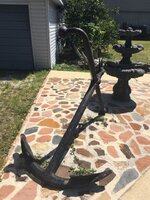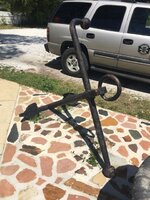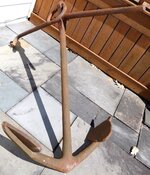You are using an out of date browser. It may not display this or other websites correctly.
You should upgrade or use an alternative browser.
You should upgrade or use an alternative browser.
Anchor,, need help identifying
- Thread starter bay pirate
- Start date
bay pirate
Full Member
- Thread starter
- #2
The 3 "W's" are who, what and when! Sorry
bay pirate
Full Member
- Thread starter
- #3
And if I need to make up a really believable story,, well,, besides "Sadds and Old Man" I'm your guy
mlutz
Full Member
- Dec 20, 2016
- 167
- 174
- Detector(s) used
-
Garrett AT Pro
Garrett Pro Pinpointer
- Primary Interest:
- Relic Hunting
I found this. It looks to be an exact match.
The anchor is of a traditional pattern known as the Admiralty Pattern, or AP, adopted by the British Admiralty in 1852, but similar in shape to anchors dating back to as early as the late 4th century BC. The U. S. Naval Academy 1891 Text-Book of Seamanship[iii] refers to this type of anchor as “a solid, iron-stocked anchor” and states that they are furnished exclusively on board ship, while wooden stocked anchors with their fixed stocks are reserved for permanent moorings.
Some modern sources refer to an anchor with this configuration as a Kedge Anchor, Fisherman’s Anchor or a Herreshoff Anchor, but this would not be historically correct for this anchor. The term Kedge refers to a smaller anchor to be used for kedging that may be a similar design but a fraction of the weight of the Bower and Sheet Anchors carried by a ship. Fisherman’s anchors and Herreshoff anchors are small boat anchors with a configuration similar to the Admiralty Pattern.
Ships transitioned away from using this type of anchor when the Stockless Anchor was developed and incorporated into ships designed with hawsepipes. The stockless anchor was patented in 1821. The process of adoption in the Royal Navy began in 1885 and was generally adopted by 1903. Of course older ships would use the old AP anchor for decades to come, and some still do.
This type of anchor could have been in use here as early as the Civil War or as late as WW2 or even later, so it will take more research to narrow down the date. The location where it was recovered was immediately north of the government reservation that is now Manchester State Park but that was previously a War Department Harbor Defense facility (1889-1919) and a Navy Net Depot during WW2.[iv] This anchor might have been used with anti-submarine nets, but the sources we found describing net operations indicated that these nets used a combination of modern stockless anchors and large concrete sinkers.[v] We understand that the anchor did not have any chain or rope attached to it when it was found, nor are there any visible markings.
We speculate that the anchor might have been used to anchor a mooring buoy and that the buoy and chain became separated from the anchor by corrosion of the shackle attaching the chain to the anchor ring.
The Structure of This Anchor
A modern source for these anchors (you can still buy them) relates the weight to the length of the shank as follows:5.5′ shank – 500 pound, 7′ shank – 1400 pound, 8′ shank – 2000 pound. The dimensions of this anchor are:Shank 80” – Stock 60” – Fluke to Fluke 60”. This would correspond to a weight of about 1200 pounds. The Smith/Scott anchor is rather crude in its shape, which would seem to indicate that it is an early one.
Image
—This drawing shows the various parts of an Admiralty Anchor. The one is question is about 80″ tall and 60″ wide.
The nomenclature for this type of anchor is described in the following illustration.
The main part of this anchor appears to have been forged from several pieces, probably two castings: the shank, and the crown and arm, and two flukes cut from plate. The shank appears to have been cast with a fork in the end where the crown piece was inserted, then forge-welded together. The flukes were probably cut with holes that fit around pins in the arms that were peened over in forging. The uniform visible layers in the flukes of this anchor indicate that the crystalline structure of the metal was aligned by rolling.
We’d like to learn more about this anchor, and if there’ someone familiar with various types of anchor forging who would like to examine it, please drop us a note.
The anchor is of a traditional pattern known as the Admiralty Pattern, or AP, adopted by the British Admiralty in 1852, but similar in shape to anchors dating back to as early as the late 4th century BC. The U. S. Naval Academy 1891 Text-Book of Seamanship[iii] refers to this type of anchor as “a solid, iron-stocked anchor” and states that they are furnished exclusively on board ship, while wooden stocked anchors with their fixed stocks are reserved for permanent moorings.
Some modern sources refer to an anchor with this configuration as a Kedge Anchor, Fisherman’s Anchor or a Herreshoff Anchor, but this would not be historically correct for this anchor. The term Kedge refers to a smaller anchor to be used for kedging that may be a similar design but a fraction of the weight of the Bower and Sheet Anchors carried by a ship. Fisherman’s anchors and Herreshoff anchors are small boat anchors with a configuration similar to the Admiralty Pattern.
Ships transitioned away from using this type of anchor when the Stockless Anchor was developed and incorporated into ships designed with hawsepipes. The stockless anchor was patented in 1821. The process of adoption in the Royal Navy began in 1885 and was generally adopted by 1903. Of course older ships would use the old AP anchor for decades to come, and some still do.
This type of anchor could have been in use here as early as the Civil War or as late as WW2 or even later, so it will take more research to narrow down the date. The location where it was recovered was immediately north of the government reservation that is now Manchester State Park but that was previously a War Department Harbor Defense facility (1889-1919) and a Navy Net Depot during WW2.[iv] This anchor might have been used with anti-submarine nets, but the sources we found describing net operations indicated that these nets used a combination of modern stockless anchors and large concrete sinkers.[v] We understand that the anchor did not have any chain or rope attached to it when it was found, nor are there any visible markings.
We speculate that the anchor might have been used to anchor a mooring buoy and that the buoy and chain became separated from the anchor by corrosion of the shackle attaching the chain to the anchor ring.
The Structure of This Anchor
A modern source for these anchors (you can still buy them) relates the weight to the length of the shank as follows:5.5′ shank – 500 pound, 7′ shank – 1400 pound, 8′ shank – 2000 pound. The dimensions of this anchor are:Shank 80” – Stock 60” – Fluke to Fluke 60”. This would correspond to a weight of about 1200 pounds. The Smith/Scott anchor is rather crude in its shape, which would seem to indicate that it is an early one.
Image
—This drawing shows the various parts of an Admiralty Anchor. The one is question is about 80″ tall and 60″ wide.
The nomenclature for this type of anchor is described in the following illustration.
The main part of this anchor appears to have been forged from several pieces, probably two castings: the shank, and the crown and arm, and two flukes cut from plate. The shank appears to have been cast with a fork in the end where the crown piece was inserted, then forge-welded together. The flukes were probably cut with holes that fit around pins in the arms that were peened over in forging. The uniform visible layers in the flukes of this anchor indicate that the crystalline structure of the metal was aligned by rolling.
We’d like to learn more about this anchor, and if there’ someone familiar with various types of anchor forging who would like to examine it, please drop us a note.
mlutz
Full Member
- Dec 20, 2016
- 167
- 174
- Detector(s) used
-
Garrett AT Pro
Garrett Pro Pinpointer
- Primary Interest:
- Relic Hunting
bay pirate
Full Member
- Thread starter
- #6
DaaaaaMMMNNNNN, that's a lot. Just kidding, seriously thank you for the details. I wish I knew the origins but I don't. I bought this house thru 2nd or 3rd hand owners and it's the original owners prize that has long been gone. What do you think the value of such could be. Aka insurance valuatuon
SADS 669
Bronze Member
- Jan 20, 2013
- 2,452
- 3,725
- Detector(s) used
- Tesoro Sand Shark....Aqua pulse 1B....Equinox ll
- Primary Interest:
- Shipwrecks
There is an anchor exactly like this just south of me in the ocean with about 150 ft of chain in a snake ( gave way under immense pressure) sadly the chain end points to deep water.....sigh
Darren in NC
Silver Member
- Apr 1, 2004
- 2,780
- 1,574
- Detector(s) used
- Tesoro Sand Shark, Homebuilt pulse loop
- Primary Interest:
- Shipwrecks
Deeper water means less chance of being salvaged. Besides, you love deep water! 
- Jun 3, 2007
- 1,190
- 1,997
- Detector(s) used
- A sharp eye, an AquaPulse and a finely tuned shrimp fork.
- Primary Interest:
- Shipwrecks
Sounds like a job for my neighbors to the south, Triton Submarines in Vero Beach. You can visit the factory while you're here!There is an anchor exactly like this just south of me in the ocean with about 150 ft of chain in a snake ( gave way under immense pressure) sadly the chain end points to deep water.....sigh
Experience Triton | Triton Submarines
Notable Expeditions | Triton Submarines
mlutz
Full Member
- Dec 20, 2016
- 167
- 174
- Detector(s) used
-
Garrett AT Pro
Garrett Pro Pinpointer
- Primary Interest:
- Relic Hunting
DaaaaaMMMNNNNN, that's a lot. Just kidding, seriously thank you for the details. I wish I knew the origins but I don't. I bought this house thru 2nd or 3rd hand owners and it's the original owners prize that has long been gone. What do you think the value of such could be. Aka insurance valuatuon
I have no clue about value. It would depend on when it was actually manufactured I would imagine. If it could be tied to a Civil War vessel, there may be even more value. I am not sure that is even possible. There should be some markings on it. It would have been tested in some fashion and would bear the marks of that testing.
Maybe you could check eBay or some site like that for a general idea of value. Good luck.
- Jun 3, 2007
- 1,190
- 1,997
- Detector(s) used
- A sharp eye, an AquaPulse and a finely tuned shrimp fork.
- Primary Interest:
- Shipwrecks
Values are all over the place for this kind of thing- you might take a look at these:
Old ship anchor for sale - The Hull Truth - Boating and Fishing Forum
or call these folks:
Ship Salvage - Nautical Antique Warehouse
http://www.crowsnesta1a.com/nautical.html
Old ship anchor for sale - The Hull Truth - Boating and Fishing Forum
or call these folks:
Ship Salvage - Nautical Antique Warehouse
http://www.crowsnesta1a.com/nautical.html
Last edited:
MPH200
Sr. Member
- Oct 26, 2012
- 425
- 677
- Detector(s) used
- Minelab Explorer SE
- Primary Interest:
- Shipwrecks
ivan salis
Gold Member
- Feb 5, 2007
- 16,794
- 3,809
- 🏆 Honorable Mentions:
- 1
- Detector(s) used
- delta 4000 / ace 250 - used BH and many others too
likely civil up to modern times ...very popular type anchor --the size / weight of anchor might tip you off to the size of vessel that used it ,,, bigger vessel needs bigger anchor
Blak bart
Gold Member
I found one just like it here in spanish wells yesterday. It was high and dry in the rocky shore at spring low tide. I think that the value is based on how bad someone wants it. About 4 years ago we sold one like that for 1400$ and we couldn't believe it. Didn't expect to get anywhere near that much so we took the first offer. It sits in the backyard near this persons pool. This person just had to have it and was willing to pay that much. I was told by several self proclaimed experts that ours was a fishermans pattern anchor from the 1800s. Our stock was held in place with a metal wedge block. I was told that indicates an older age. I'llLn take a picture of the one I found yesterday when the wind stops blowing and I can get to it.
Top Member Reactions
-
 2404
2404 -
 1116
1116 -
 1111
1111 -
 901
901 -
 819
819 -
 807
807 -
 764
764 -
 733
733 -
 644
644 -
 518
518 -
 476
476 -
 468
468 -
 459
459 -
 429
429 -
 414
414 -
 408
408 -
O
369
-
 362
362 -
 353
353 -
 348
348
Users who are viewing this thread
Total: 2 (members: 0, guests: 2)
Latest Discussions
-
Recent finds - Large Cents, Jaw Harp, Cufflink, Buckle and Buttons
- Latest: detectorcowboy
-
-
-
-








